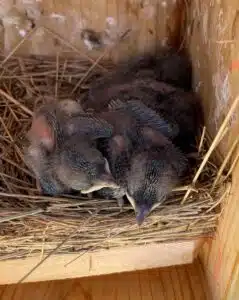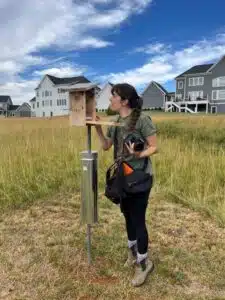 Bird populations have been decreasing across the globe for the past 50 years. Bluebird populations in particular experienced a dramatic decrease in population size in the early 20th century, reaching a 90% population decrease at one point. Largely due to habitat loss and introduction of aggressive species that outcompeted bluebirds for their resources. However, bluebirds are one of conservations greatest success stories. Without human interaction they could have been lost forever. However, the North American Bluebird Society was created in 1978 and advocated for the use of nesting boxes.
Bird populations have been decreasing across the globe for the past 50 years. Bluebird populations in particular experienced a dramatic decrease in population size in the early 20th century, reaching a 90% population decrease at one point. Largely due to habitat loss and introduction of aggressive species that outcompeted bluebirds for their resources. However, bluebirds are one of conservations greatest success stories. Without human interaction they could have been lost forever. However, the North American Bluebird Society was created in 1978 and advocated for the use of nesting boxes.
Bluebirds are secondary cavity nesting birds, which means they don’t have the ability to make their own cavities like woodpeckers, but rather make nests in pre existing cavities. Their aggressive competitors, like European starlings and house sparrows, are also cavity nesting birds and will take over bluebird nests. But the North American Bluebird Society designed a nesting box with a hole small enough for bluebirds but not large enough for predatory or competitor birds. These nesting boxes, along with other conservation techniques, saved the bluebird population and it is actually steadily increasing; they are now considered a species of low conservation concern.
Bluebirds are an important part of any ecosystem, they are natural pest control. They eat harmful bugs and insects that can otherwise damage crops and property. They also aid in pollination and seed dispersal which is vital for plant reproduction and has a major impact on the health of an ecosystem and its biodiversity.
Here at Willowsford, supporting our local wildlife populations is a top priority. In 2013, a bluebird monitoring trail was established in The Grange village with 10 boxes. Now, we currently have bluebird monitoring trails in The Grange, The Grove, and most recently, The Grant with 29 boxes total.

Each spring, we host a bluebird monitoring training that gives volunteers background about the program and a run down on what their responsibilities will be. The season runs from March until August. During this time, volunteers sign up to check boxes of their choosing throughout the summer. Monitors record their data in a google form and at the end of the season it is collated and sent out to the Loudoun Wildlife Conservancy and the Virginia Bluebird Society. This data helps to determine population trends for the area.
Monitoring the bluebirds not only gives us important data about their population, but it actually increases their chances for successful broods. Consistent monitoring can help identify potential predators or damages to the box that could make the birds vulnerable. Compiling this data can also give us information about environmental shifts like climate change.
This year, we reached a record high for the number of bluebirds that fledged from our boxes with a grand total of 65! That is a major increase from the 21 that fledged last year, and is significantly higher than our previous record in 2019, which was 49 total fledglings.
Volunteering to help monitor for the bluebird program is a great way to get involved with conservation work. It can even be great for kids! You get to watch as birds choose a mate, build a nest, and start a family.
If you’d like to volunteer for the program or learn more please email elawrence@willowsfordconservancy.org
Learn more:
Why Are Bluebirds Important? – Cedar Run Wildlife Refuge
